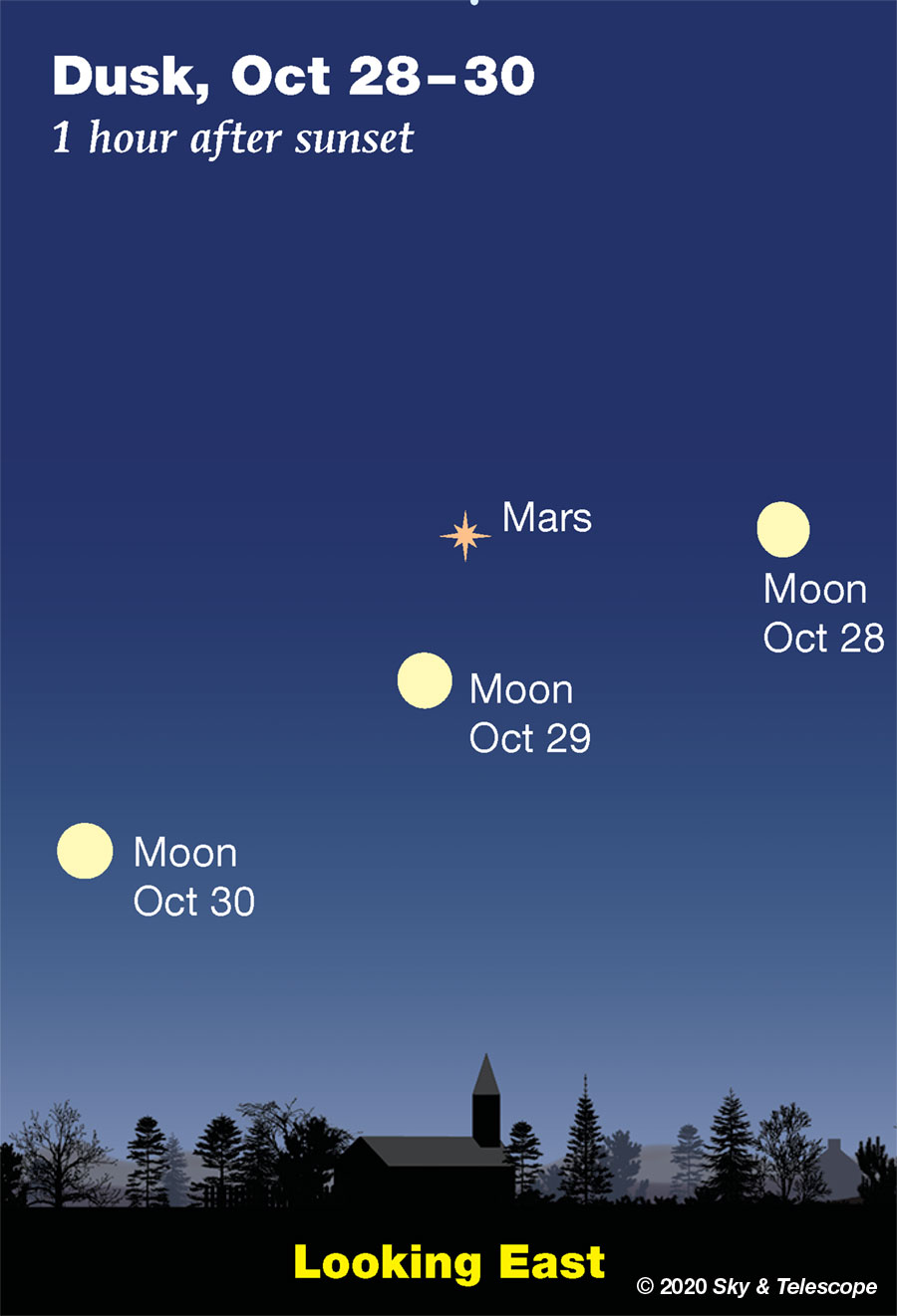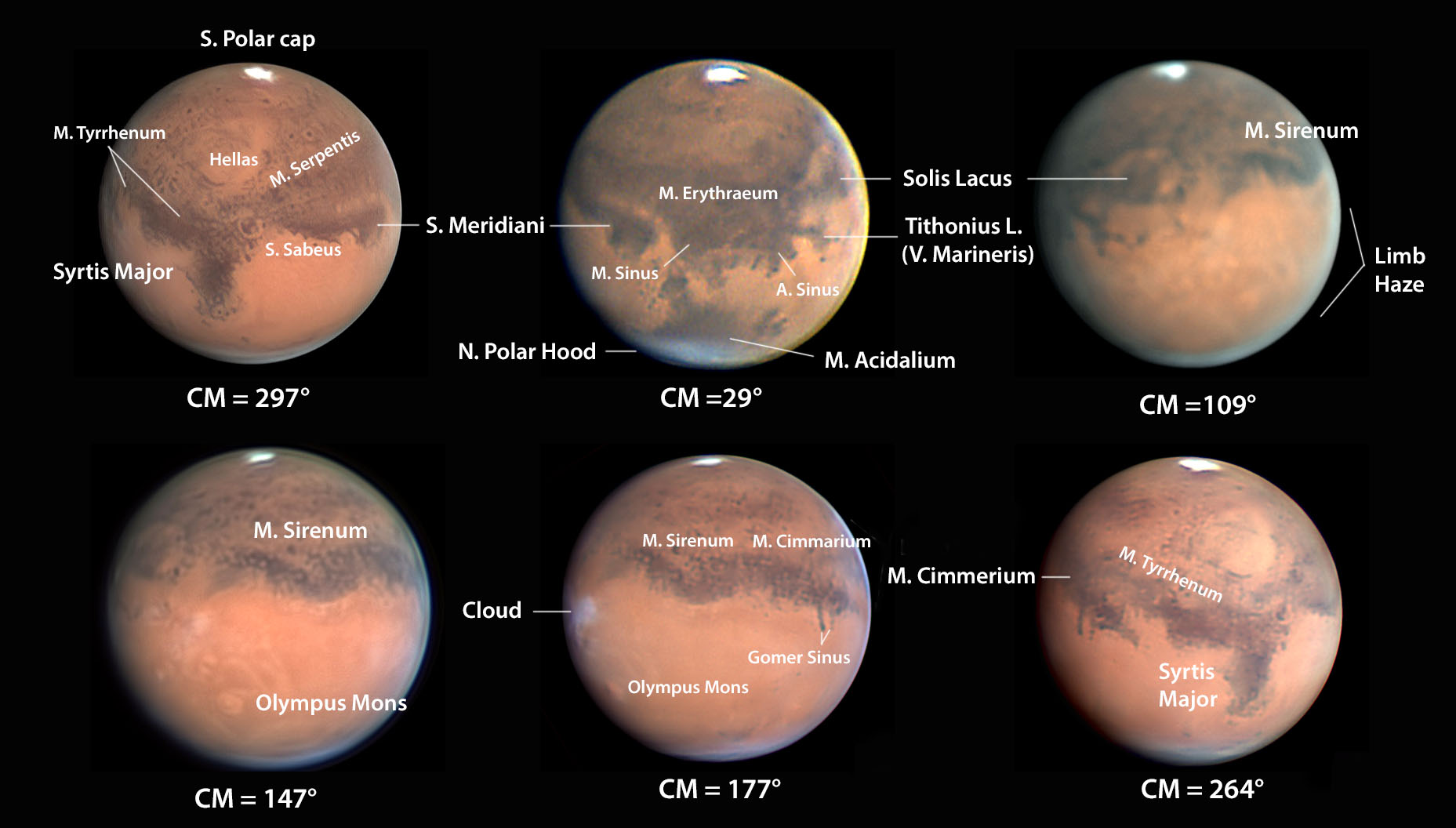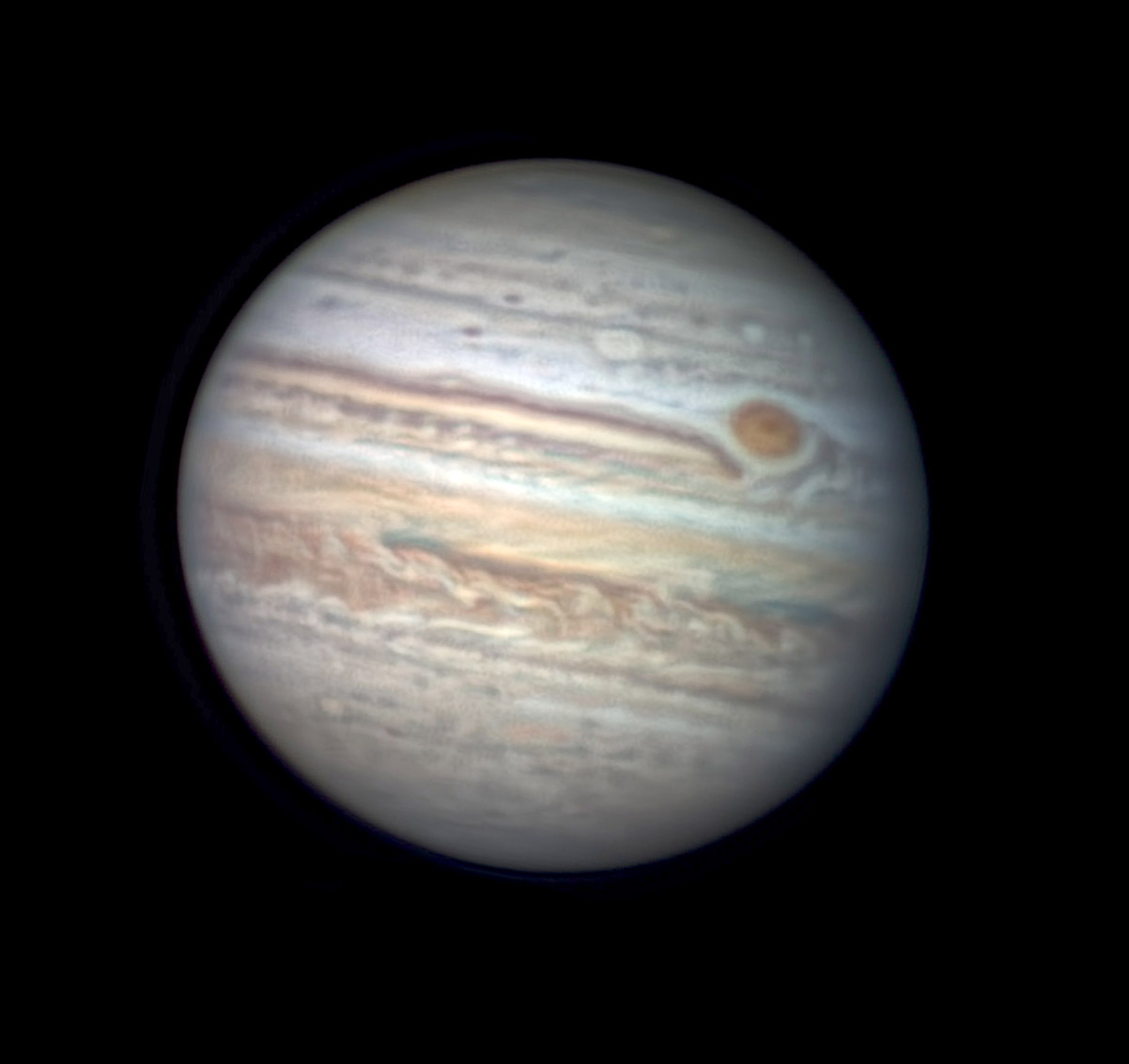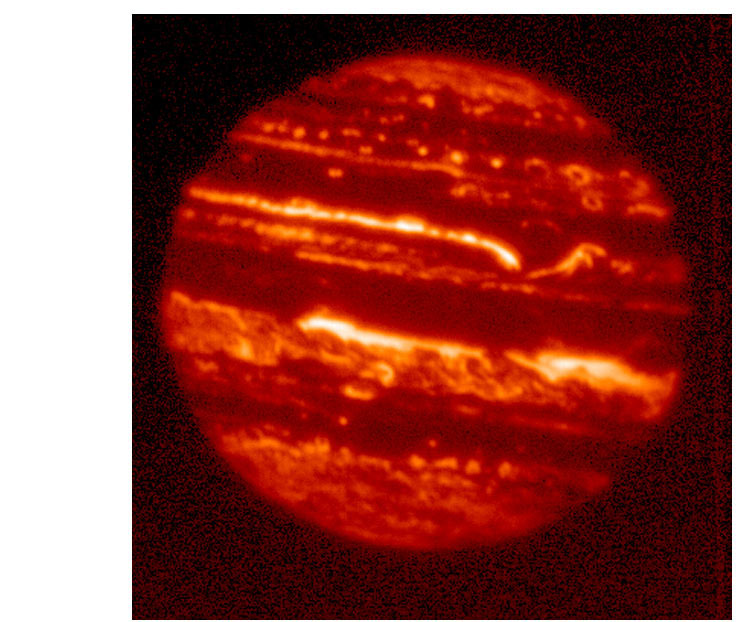
FRIDAY, OCTOBER 23
■ First-quarter Moon, exact at 9:23 a.m. Eastern Daylight Time. By evening, about half a day later for North America, the Moon's terminator will be just a bit convex. The Moon will shine in dim Capricornus — left of Jupiter and Saturn at dusk, and upper left of them as the evening grows late.
■ Jupiter's Great Red Spot should transit Jupiter's central meridian around 7:10 p.m. Pacific Daylight Time. (The West Coast is having its good view of Jupiter around then.)
SATURDAY, OCTOBER 24
■ The Moon, now a day and a half past first quarter, shines in Capricornus. It forms the top of a very wide, flat, almost isosceles triangle with Fomalhaut, about two fists at arm's length to the Moon's left and a little lower, and Saturn, about two fists to the Moon's right and a little lower. Brighter Jupiter shines a little beyond Saturn.
Fomalhaut and Saturn balance at the same height around 9 p.m. daylight-saving time, depending on your location.
SUNDAY, OCTOBER 25
■ The ghost of Summer Suns. Halloween is approaching, and this means that Arcturus, the star sparkling low in the west-northwest in twilight, is taking on its role as "the Ghost of Summer Suns." What does this mean? For several days centered on October 25th every year, Arcturus occupies a special place above your local landscape. It closely marks the spot where the Sun stood at the same time, by the clock, during hot June and July — in broad daylight, of course!
So, as Halloween approaches every year, you can see Arcturus in twilight as the chilly ghost of the departed summer Sun.
MONDAY, OCTOBER 26
■ After dark, Capella sparkles low in the northeast. The farther north you are, the higher it will be. To the right of Capella, by about three fists at arm's length, the Pleiades are climbing into view. And soon Aldebaran will rise below the Pleiades.
Upper right of Capella, and upper left of the Pleiades, the stars of Perseus lie astride the Milky Way.
TUESDAY, OCTOBER 27
■ The waxing gibbous Moon shines in the southeast after dark. Way to its left is fire-colored Mars. A little farther to the Moon's lower right, you'll find Fomalhaut. And somewhat closer below the Moon is Beta Ceti or Diphda, less bright.
A sky landmark to remember: Once you find the Great Square of Pegasus (high above the Moon tonight and maybe a bit left), its east and west sides always point down roughly to Beta Ceti and Fomalhaut, respectively.
WEDNESDAY, OCTOBER 28
■ The Summer Triangle Effect. Here it is the end of October, but Deneb still shines right near the zenith as the stars come out. And brighter Vega is still not far from the zenith, toward the west. And the third star of the "Summer" Triangle, Altair, remains very high in the southwest (high over Jupiter and Saturn). They seem to have been there for a couple months! Why have they stalled out?
What you're seeing is the result of sunset and darkness arriving earlier and earlier during autumn. Which means if you go out and starwatch soon after dark, you're doing it earlier and earlier by the clock. This counteracts the seasonal westward turning of the constellations. If you made a point of always doing your skywatching at the same time by the clock, the constellations would proceed as always.
Of course the "Summer Triangle effect" applies to the entire celestial sphere, not just the Summer Triangle. But the apparent stalling of that bright landmark inspired Sky & Telescope to give the effect that many years ago, and it has stuck ever since.
Of course, as always in celestial mechanics, a deficit somewhere gets made up elsewhere. The opposite effect makes the seasonal advance of the constellations seem to speed up in early spring. The spring-sky landmarks of Virgo and Corvus seem to move away westward from week to week almost before you know it, due to darkness coming later. Let's call this the "Corvus effect."
■ Jupiter's Great Red Spot should transit the planet's central meridian around 6:20 p.m. Pacific Daylight Time. Jupiter is in fairly good view for the Pacific time zone around then. But don't be too disappointed; not only is Jupiter getting fairly low in fuzzy, shimmery seeing, it has also been getting somewhat farther and smaller since its July opposition.
THURSDAY, OCTOBER 29
■ Mars and the bright gibbous Moon accompany each other across the sky tonight. Or so it appears. Mars is actually 170 times farther away and twice the Moon's physical size (diameter).
High above them in early evening, the Great Square of Pegasus balances on one corner.
■ This is the time of year when the Big Dipper lies level low in the north-northwest in early to mid-evening. How low? The farther south you are, the lower. Seen from 40° north (New York, Peoria, Denver) even its bottom stars twinkle nearly ten degrees high. But at Miami (26° N), the entire Dipper skims along out of sight just below the horizon.
FRIDAY, OCTOBER 30
■ Vega is the brightest star very high in the west these evenings. Its little constellation Lyra extends to its left, pointing as always to Altair, currently the brightest star high in the southwest.
Three of Lyra's leading stars, after Vega, are interesting doubles. Barely above Vega is 4th-magnitude Epsilon Lyrae, the Double-Double. Epsilon forms one corner of a roughly equilateral triangle with Vega and Zeta Lyrae. The triangle is less than 2° on a side, hardly the width of your thumb at arm's length.
Binoculars easily resolve Epsilon. And a 4-inch telescope at 100× or more should resolve each of Epsilon's wide components into a tight pair.
Zeta Lyrae is also a double star for binoculars; much tougher, but plainly resolved in a telescope.
And Delta Lyrae, a similar distance upper left of Zeta, is a much wider and easier binocular pair.
SATURDAY, OCTOBER 31
■ Full Moon for Halloween. The Moon (exactly full at 10:49 a.m. EDT) rises in the east about a half hour after sunset, depending on your location. This is the second full Moon in calendar October in many of the world's time zones, including those of the Americas, making this a "blue moon" for those time zones.
That bright orange dot off to its upper right is Mars.
After dark, you'll find the modest stars of little Aries above the Moon by about a fist and a half at arm's length, if you can make them out through the moonlight.
Above Aries, by a roughly similar amount, is the much longer line of stars forming the main line of the constellation Andromeda, sort of horizontal-ish and two or three fists from end to end.
Meanwhile, in the west-southwest you'll find bright Jupiter and, upper left of Jupiter by half a fist, lesser Saturn.
■ Uranus is at opposition.
This Week's Planet Roundup
Mercury is hidden in deep in the glow of sunrise. But not for long! Next week it will jump up into good dawn view.
Venus (magnitude –4.0) shines brightly in the east before and during dawn. It's now in the dim head of Virgo, "the lair of the Lion" under Leo. Venus rises in deep darkness more than an hour before dawn begins. Once dawn is under way, it's in fine view as the bright "Morning Star" in the east.
Look to Venus's upper left, by a fist at arm's length or more, for 2nd-magnitude Denebola, Leo's tail-tip as he strides diagonally upward.
In a telescope Venus is a dazzling little gibbous ball, just 13 or 14 arcseconds from pole to pole.
Mars (about magnitude –2.3, in Pisces) passed through opposition on October 13th and is still much larger and brighter than we usually see it. This week it's about 21 arcseconds in diameter, climbing into fine, high telescopic view earlier in the night.
At dusk Mars glares fiery orange, a trace more than Jupiter-bright, fairly low in the east. It's high in the southeast by 9 or 10 p.m. daylight-saving time, and it's highest at its telescopic best by 11 or midnight, blazing in the south.

See Bob King's "A Great Year for Mars" in the October Sky & Telescope, page 48, and his Behold Mars! online. To get a map of the side of Mars facing Earth at the date and time you'll observe, you can use our Mars Profiler. The map there is square; remember to mentally wrap it onto the side of a globe. (Features near the map's edges become very foreshortened; compare with the images above.)
Jupiter and Saturn (magnitudes –2.2 and +0.6, respectively) tilt down in the west-southwest these evenings. Get your telescope on them early, before the end of twilight, before they sink lower toward the southwest later in the evening. But don't expect much; both are somewhat farther and smaller than they were during summer.
Jupiter is the bright one; Saturn is about 5½° to its upper left. Watch them creep toward each other for the rest of the fall. They'll pass just 0.1° apart at conjunction on December 21st, low in twilight, right when fall turns to winter.
Follow the interplay of Jupiter with its moons and their shadows, and find all the transit times of Jupiter's Great Red Spot, using the Celestial Calendar section of the October Sky & Telescope.


The blue festoon bases, and smaller slightly bluish markings at high latitudes, are areas of clear air that allow a somewhat deeper view. And that's why, at visible wavelengths, they are blue! Clear Jupiter-air preferentially scatters the blue wavelengths in sunlight, just like molecular scattering by clear air on Earth makes our own sky blue.
Uranus (magnitude 5.7, in Aries) is well up in the east by 9 p.m. daylight-saving time, about 20° east of Mars. Uranus is only 3.7 arcseconds wide, but that's enough to appear as a tiny fuzzy ball, not a point, at high power in even a good small telescope.
Neptune (magnitude 7.8, in Aquarius) is a little higher in the south-southeast at that time. Neptune is 2.3 arcseconds wide, harder to resolve except in good seeing. Check in on them when you're done with Mars: Finder charts for Uranus and Neptune.
All descriptions that relate to your horizon — including the words up, down, right, and left — are written for the world's mid-northern latitudes. Descriptions that also depend on longitude (mainly Moon positions) are for North America.
Eastern Daylight Time, EDT, is Universal Time minus 4 hours. (Universal Time is also known as UT, UTC, GMT, or Z time.)
Want to become a better astronomer? Learn your way around the constellations. They're the key to locating everything fainter and deeper to hunt with binoculars or a telescope.
This is an outdoor nature hobby. For an easy-to-use constellation guide covering the whole evening sky, use the big monthly map in the center of each issue of Sky & Telescope, the essential magazine of astronomy.
Once you get a telescope, to put it to good use you'll need a detailed, large-scale sky atlas (set of charts). The basic standard is the Pocket Sky Atlas (in either the original or Jumbo Edition), which shows stars to magnitude 7.6.

Next up is the larger and deeper Sky Atlas 2000.0, plotting stars to magnitude 8.5; nearly three times as many. The next up, once you know your way around, are the even larger Interstellarum atlas (stars to magnitude 9.5) or Uranometria 2000.0 (stars to magnitude 9.75). And be sure to read how to use sky charts with a telescope.
You'll also want a good deep-sky guidebook, such as Sky Atlas 2000.0 Companion by Strong and Sinnott, or the bigger (and illustrated) Night Sky Observer's Guide by Kepple and Sanner.
Can a computerized telescope replace charts? Not for beginners, I don't think, and not on mounts and tripods that are less than top-quality mechanically, meaning heavy and expensive. And as Terence Dickinson and Alan Dyer say in their Backyard Astronomer's Guide, "A full appreciation of the universe cannot come without developing the skills to find things in the sky and understanding how the sky works. This knowledge comes only by spending time under the stars with star maps in hand."
![]() Audio sky tour. Out under the evening sky with your
Audio sky tour. Out under the evening sky with your
earbuds in place, listen to Kelly Beatty's monthly
podcast tour of the heavens above. It's free.
"The dangers of not thinking clearly are much greater now than ever before. It's not that there's something new in our way of thinking, it's that credulous and confused thinking can be much more lethal in ways it was never before."
— Carl Sagan, 1996
"Facts are stubborn things."
— John Adams, 1770
 4
4








Comments
Rod
October 24, 2020 at 8:53 am
mary beth/New Jersey Eclipse Fan et al. I enjoyed some stargazing last night using my 10-inch Newtonian with 2-inch eyepiece. Excellent views of M31, M32, and M110, the Andromeda galaxy with dwarf galaxies. The Double Cluster in Perseus was wonderful. The eyepiece provided nearly 2-degree true field of view and many other stars visible in the field along with the Double Cluster. Mars was up but behind some trees near where I was at. After I setup the 10-inch at close to 60 lbs. or so, I do not pick it up and move it around to other locations 🙂 I panned through Cassiopeia too and observed a number of double stars. There were bucks calling, some owls active, and at times, I could hear dear moving through the woods stepping on branches and leaves. Hunters in blinds like that sound 🙂
You must be logged in to post a comment.
New Jersey Eclipse Fan
October 26, 2020 at 12:32 pm
Thanks for your observations, Rod. I do not hunt but grew up in Pa. and learned a lot from people I used to work with when I lived there. Another thing hunters love is a fresh snowfall, which makes it a cinch to spot deer tracks.
You must be logged in to post a comment.
mary beth
October 27, 2020 at 1:32 pm
Hello Rod and NJEF!
Mars is still beautiful. I feel I can tell just with my eyes that it is decreasing in magnitude..or maybe it is just my imagination since I know it was brightest on the 13th. I’ll have to look at the magnitude from last week’s column. So we have a red-orange object in the East and West ...perfect Halloween backdrop! Rod, have you viewed Arcturus with your scope this autumn?
I noticed the Hubble flyover showing on Stellarium. Never seen that before, very nice. Its been somewhat hard to find a website for flyover information. I have visited a site called ‘heavens above’ and it does have some good information about Hubble. Very convenient on the app!
Beware: we might just see a witch, ghost or vampire bat while stargazing!!
You must be logged in to post a comment.
Rod
October 27, 2020 at 7:43 pm
mary beth, no for Arcturus viewing, focused on Mars and other targets now. Here at my location, clouds now and likely 1-2 inches of rain coming from Zeta for Thurs-Friday. Saturday looks better. Hunter Moon and Mars rising in the East 🙂 The latest edition of Stellarium also shows when ISS passes over too. While stargazing, I am not concerned what is out there, especially during a Hunter's Moon 🙂
You must be logged in to post a comment.
You must be logged in to post a comment.